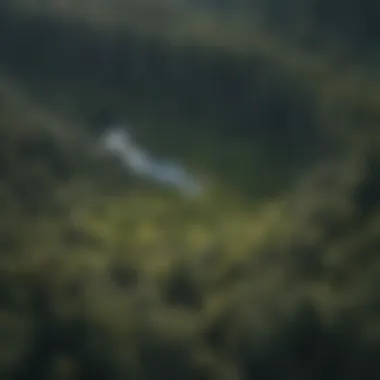Exploring Lidar Satellites for Forestry Management


Intro
The fusion of technology and ecology has led to significant advancements in various fields, particularly in forestry. Lidar satellite technology emerges as a transformative player in understanding and managing forests globally. Recent developments have shown that this laser-based remote sensing technique provides unprecedented detail about forest structures, allowing for improved mapping and assessment. This article delves into lidar's operational mechanisms and explores its implications for sustainable practices and biodiversity preservation within woodland environments.
Overview of Forestry Practices
Definition of Forestry
Forestry refers to the science and practice of managing forests. It encompasses a variety of activities, including planting, maintaining, and harvesting trees, along with preserving wildlife habitats. The field integrates ecological, economic, and social dimensions. A well-managed forest contributes significantly to environmental balance and sustainability.
Importance of Forestry in Ecosystem Management
Forests play a crucial role in ecosystem management. They help regulate the climate, maintain soil health, and support various species. Furthermore, forests are vital in carbon sequestration, thereby mitigating climate change effects. Sustainable forestry ensures that these benefits are preserved for future generations. Effective management strategies must focus on maintaining ecological integrity while meeting human needs.
Sustainable Forest Management
Principles of Sustainable Practices
Sustainable forest management hinges on several principles:
- Biodiversity Conservation: Upholding multiple species and ecosystems fosters resilience.
- Resource Availability: Ensuring that forest resources are used efficiently and responsibly.
- Community Involvement: Engaging local communities integrates traditional knowledge with modern practices.
- Economic Viability: Balancing ecological protections with economic gains is essential for sustainability.
Techniques in Sustainable Management
Various techniques aid in achieving sustainable forest management. These include:
- Selective Logging: This method reduces the impact on the forest by allowing certain trees to remain standing.
- Agroforestry: Combining agriculture with forestry enhances land productivity and biodiversity.
- Reforestation: Planting trees on deforested land restores ecological balance and carbon storage potential.
Woodland Stewardship Strategies
Importance of Woodland Stewardship
Woodland stewardship focuses on the responsible management of forested areas. It encompasses individual landowners, communities, and organizations working together to enhance forest health and sustainability. Effective stewardship incorporates long-term planning to adapt to climate change and land-use pressures.
Best Practices for Landowners
Landowners can adopt several best practices to ensure responsible stewardship of their woodlands:
- Conducting Regular Assessments: Monitoring forest health helps in making informed management decisions.
- Engaging with Experts: Collaborating with forestry professionals provides valuable insights into sustainable practices.
- Educating the Community: Raising awareness about the importance of forestry fosters a culture of stewardship among local populations.
"Lidar technology represents a key tool for enhancing our understanding of forest dynamics and improving management practices."
The integration of lidar satellite technology with these forestry practices can potentially revolutionize how we manage and conserve forests. As we examine how lidar contributes to mapping, monitoring, and decision-making, the future of forest management appears promising.
Foreword to Lidar Satellite Technology
Lidar satellite technology offers a revolutionary approach to understanding and managing forestry resources. The capability to capture detailed three-dimensional information about forest structure makes this technology indispensable in modern forestry practices. It provides precise measurements that enable professionals to plan, monitor, and analyze forests with a level of accuracy that was previously unattainable.
Lidar, which stands for Light Detection and Ranging, utilizes laser beams to gather data about distances to the Earth's surface. This enables more effective forest mapping, biodiversity assessments, and overall sustainable management practices. As issues related to climate change and forest conservation grow more pressing, the significance of lidar technology in addressing these challenges increases.
In the context of this article, we aim to dissect the mechanics and applications of lidar technology in forestry. We will examine the foundational aspects of lidar, including its definition, historical developments, and key components. Understanding these elements is crucial for forestry professionals and academics, as they navigate the complexities of forest management in an evolving technological landscape.
Mechanisms of Lidar Satellite Operation
Understanding the mechanisms of lidar satellite operation is vital for appreciating its transformative role in forestry. These systems enable accurate data collection and analysis. They help in understanding various aspects of forest ecosystems, including structure and health. Different components work together to provide the detailed insights necessary for effective forest management and conservation.
How Lidar Works


Laser Emission
Laser emission is the first step in the lidar process. A laser beam is transmitted towards the earth's surface. This emission is characterized by high precision and consistency, which is essential for reliability. The advantage of using laser light is that it penetrates canopy layers effectively. This enables the collection of data from multiple forest levels, a critical aspect in forestry studies. However, one downside is that the cost of lasers can be high, impacting the overall equipment expenses.
Reflection and Detection
After the laser beam strikes an object, such as a tree or the ground, it reflects back towards the satellite. This reflection is crucial as it contains the data needed for analysis. The key characteristic of this stage is the ability to measure the time it takes for the light to return. This allows determination of distances and shapes of objects in the forest. A notable feature is its effectiveness in complex environments, allowing detailed forest structure assessment. However, this method can be limited by atmospheric conditions that affect the laser signal.
Data Processing
Data processing is the final step in the lidar operation. It involves converting the raw data from the reflected signals into usable information. This step is vital for creating accurate 3D models of the forest. The characteristic advantage here is the ability to handle large datasets swiftly, enabling researchers to analyze extensive areas efficiently. A unique feature of lidar data processing is its capacity to integrate with other geospatial technologies. This integration can lead to insights that are not easily available through traditional methods. Challenges exist, including the need for specialized software and expertise.
Types of Lidar Satellites
Lidar satellites come in different types, each with unique applications in forestry. Understanding these types is key to utilizing the correct technology for specific needs.
Terrestrial Lidar
Terrestrial lidar systems are located on the ground and are often utilized for precise measurements in smaller areas. Their key characteristic is the ability to capture detailed information about individual trees and smaller sections of forests. This makes them popular for urban forestry and detailed ecological assessments. A notable advantage of terrestrial lidar is its high resolution and accuracy, but it is limited by its operational area and may be less effective for large-scale assessments.
Airborne Lidar
Airborne lidar systems use aircraft to scan forested areas from above. They offer a broader coverage compared to terrestrial systems. A key benefit lies in their efficiency; they can gather data over large landscapes in a shorter time period. The unique feature of airborne lidar is its adaptability to various altitudes and speeds, which can optimize data collection under diverse conditions. The disadvantage may be related to the high costs associated with aircraft operation and data processing.
Spaceborne Lidar
Spaceborne lidar satellites operate from orbit and provide a global perspective on forestry. They can monitor vast areas without the limitations of ground-based systems. The key characteristic is their ability to access remote and difficult terrains that are not feasible for airborne systems. Spaceborne lidar systems significantly benefit global monitoring initiatives for climate and biodiversity. However, the resolution may not match that of terrestrial and airborne systems, potentially limiting their application in detailed local studies.
Applications of Lidar in Forestry
Lidar technology has proven itself to be indispensable in the realm of forestry. It offers several applications that enhance our understanding and management of forest ecosystems. By employing lidar, forestry professionals can analyze the spatial structure of forests, assess biodiversity, measure carbon stocks, and create accurate maps and inventories of forest resources. These applications empower stakeholders to make informed decisions regarding sustainable forest management and conservation efforts.
Forest Structure Analysis
Understanding forest structure is vital for effective management and conservation. Lidar offers three-dimensional insight into tree heights, canopy density, and forest floor variations. These metrics help in evaluating habitat quality and guide regeneration practices. Using data from terrestrial, airborne, or spaceborne lidar systems, researchers can model forest canopies at a high degree of precision. This analysis aids in recognizing how external factors, such as climate and human activities, impact forest composition and health. It also plays a crucial role in planning interventions.
Biodiversity Assessment
Lidar technology significantly contributes to biodiversity assessments by providing detailed information on vegetation types and distributions within a forest. This data assists in identifying habitat requirements. Moreover, by mapping different layers of vegetation, researchers can monitor species diversity and detect any changes over time. The high-resolution maps generated through lidar help in pinpointing areas that require conservation efforts or habitat restoration. This becomes increasingly important in the context of climate change, where shifts in biodiversity patterns demand quick and informed responses.
Carbon Stock Measurement
Accurate measurement of carbon stocks in forested areas is integral to combating climate change. Lidar helps determine biomass and carbon content by estimating tree height and density. This information enables the calculation of carbon stocks at a landscape level, which is essential for carbon credit trading and environmental policy-making. By continuously monitoring these carbon stocks, it's possible to assess the effectiveness of reforestation and conservation initiatives. Moreover, lidar provides a more reliable alternative to traditional methods, which can be time-consuming and less accurate.
Mapping and Inventorying Forest Resources
The role of lidar in mapping and inventorying forest resources is transformative. Precision mapping allows for detailed assessments of timber resources, including species composition and wood volume. This data supports sustainable harvest planning and operational efficiency. Furthermore, lidar technology facilitates the identification of forest disturbances, such as pest outbreaks or logging impacts. The ability to quickly map large areas ensures that forestry operations are responsive and data-driven. Using lidar-generated maps, stakeholders can engage better in forest management and advocacy for resource allocation.
Lidar not only enhances our understanding of forest ecosystems but also equips us with the tools to make informed, proactive decisions for their management and preservation.
Integration with Other Technologies
Lidar satellite technology does not exist in isolation. Its synergy with various other technologies enhances its capabilities and provides deeper insights for forest management. The integration with geospatial technologies, remote sensing, and machine learning signifies a leap in data analysis, facilitating better decision making in forestry.
Geospatial Technologies
Geospatial technologies, including Geographic Information Systems (GIS), play a critical role in the analysis and interpretation of Lidar data. These technologies allow for the spatial visualization of forest ecosystems. By combining Lidar data with GIS, forestry professionals can create detailed maps that visualize tree heights, density, and biomass distribution across vast areas. This integration aids in understanding landscape changes over time and pinpointing areas needing conservation or restoration efforts. Moreover, geospatial technologies help in analyzing the relationship between forest structures and environmental variables, thus providing insights into biodiversity and ecosystem health.
Key benefits of this integration include:


- Enhanced data visualization through thematic mapping.
- Better resource allocation and management strategies.
- Improved monitoring of forest changes and health over time.
Remote Sensing and GIS
Remote sensing technology complements Lidar by providing additional data layers for robust analysis. While Lidar offers precise three-dimensional data, remote sensing includes satellite imagery and aerial photographs, which contribute to surface characteristics and broader landscape context. This combination allows for comprehensive assessments of forest resources, forest cover, and land-use changes. For instance, multispectral and hyperspectral images captured from satellites can reveal vegetation health, while Lidar elucidates the vertical structure of canopies.
Together, these technologies create a more holistic understanding of forests, allowing for:
- More accurate ecosystem modeling.
- Effective identification of forest degradation or deforestation processes.
- Informed land-use planning and policy-making.
Machine Learning Applications
Machine learning algorithms provide powerful tools to interpret and analyze large sets of Lidar and other remote sensing data. By applying advanced machine learning techniques, forestry experts can uncover patterns and predict trends that may not be apparent through traditional analysis. For example, supervised learning can be used to classify species based on Lidar's structural data, while unsupervised learning can identify underlying structures in complex forest ecosystems.
The benefits of integrating machine learning with Lidar technology include:
- Increased accuracy in species identification and forest health assessments.
- Ability to handle and process large volumes of data efficiently.
- Improved forecasting of forest dynamics under changing climate conditions.
"Integrating Lidar technology with machine learning transforms raw data into actionable insights, enabling smarter forest management strategies."
In summary, the interplay between Lidar and these emerging technologies results in substantial advancements for forestry professionals. This collaborative approach allows for a more detailed and nuanced understanding of forest environments, essential for effective and sustainable forest management.
Lidar Data Interpretation and Challenges
Lidar data interpretation and the challenges associated with it are critical components in understanding how this technology can be effectively utilized in forestry. Data interpretation determines the accuracy and usability of the information gathered through Lidar systems. Given the complexities inherent in forest environments, accurate data interpretation can facilitate effective forest management, conservation, and planning.
Interpretation involves translating raw data measurements into actionable insights. For forestry professionals, this means converting measurements of distance, height, and density into detailed models of forest structure and habitat characteristics. This process is essential for identifying species composition, assessing health and vitality, and planning interventions when necessary. Moreover, interdisciplinary collaboration is imperative to enhance the accuracy and relevance of interpretations, ensuring all factors affecting the forest ecosystem are accounted for.
Data Processing Techniques
Data processing comprises the steps taken to convert raw Lidar data into meaningful outputs. One fundamental technique is the use of algorithms to filter and classify data points. Filtering removes noise from the dataset, which may result from atmospheric interference or other sources. Once cleaned, the data can be classified using machine learning or statistical methods to categorize different forest features.
Some specific processing techniques include:
- Digital Elevation Model (DEM) generation: This involves producing terrain models that represent the ground level, essential for analyzing landforms and hydrology.
- Canopy Height Models (CHM): Techniques to derive a representation of the forest canopy height, this model assists in understanding vertical forest structure.
- Point Cloud Analysis: Utilizing point cloud data to visualize and extract metrics like tree density, crown sizes, and gaps within the canopy.
These processing techniques require a sophisticated understanding of both Lidar data characteristics and specific software tools. Programs such as LASTools or LiDAR360 are commonly employed to facilitate this analysis. Effective processing is not only vital for getting accurate data, but it also influences the quality of insights derived for forestry practices.
Common Challenges in Data Collection
While Lidar offers significant advantages, it is not without challenges during data collection. A few common issues include:
- Atmospheric Interference: Lidar signals can be affected by weather conditions such as fog, rain, or even high humidity, leading to inaccuracies in the data collected.
- Vegetation Density: High-density canopies may obstruct Lidar signals, resulting in a lack of data concerning lower vegetation layers, which can affect biodiversity assessments.
- Data Volume: The sheer amount of raw data produced can be daunting, requiring robust storage solutions and efficient processing capabilities.
- Calibration and Validation: Accurate interpretations require calibrated instruments and validation with field data, which is often a labor-intensive endeavor.
Understanding these challenges is essential for forestry professionals who wish to leverage Lidar technology effectively. Each challenge presents important considerations that can impact outcomes and should be strategically addressed during the planning and execution stages of data collection.
Impact on Sustainable Forest Management
The significance of sustainable forest management cannot be overstated in the context of global environmental conservation strategies. Lidar satellite technology plays a pivotal role in achieving sustainable practices. By providing precise data about forest structure, health, and changes over time, it aids forestry professionals in making informed decisions. Sustainable forestry is not just about conserving nature; it is about balancing ecological health with economic viability. The integration of lidar technology enhances this balance.
Promoting Sustainable Practices
Sustainable forestry practices hinge on accurate data collection and monitoring. Lidar technology contributes significantly by offering high-resolution maps that depict tree heights, canopy density, and biomass distribution. This data empowers forest managers to assess the sustainability of current practices and identify areas requiring intervention.
- Enhanced decision-making: With lidar, decisions regarding tree harvesting, replanting, and conservation zones can be made with greater confidence.
- Monitoring ecosystems: Continuous monitoring enables detection of illegal logging activities or other unsustainable practices early. This leads to timely action for environmental protection.
- Impact on biodiversity: Understanding the vertical and horizontal structure of forests allows for better conservation strategies. Habitat protection is crucial for maintaining biodiversity.
In summary, by promoting data-driven sustainable practices, lidar technology ensures that forestry management is responsive and responsible.
Long-Term Forest Health Monitoring


Long-term monitoring of forest health is essential for sustainability. Lidar technology excels in this area by enabling repeated assessments over extended periods.
Benefits include:
- Baseline data collection: Establishes a clear understanding of forest conditions at specific times.
- Change detection: Identifies changes caused by climate change, pest invasions, or natural disasters. This knowledge helps in adapting management practices accordingly.
- Ecological resilience: Through continuous assessment, forest managers can foster habitats that better resist future environmental stresses.
By ensuring regular monitoring through lidar technology, forestry professionals can take preventative or corrective measures to maintain forest health effectively.
Community Involvement and Policy Implications
Community engagement is critical for the success of sustainable forest management practices. Lidar provides unique opportunities for involving the public and stakeholders in forestry decisions.
- Education and awareness: Lidar-generated data can be visually represented in a way that is accessible to the public. This visualization fosters understanding and appreciation of forest ecosystems.
- Stakeholder collaboration: Engaging community members through data sharing can lead to collaborative management efforts that respect local knowledge and practices.
- Policy support: Accurate data from lidar can inform policy decisions at local, regional, and national levels. Such informed policies can strengthen sustainable practices and regulatory frameworks.
"Data-driven decisions empower communities, leading to more effective conservation strategies and fostering a shared responsibility in forest management."
To encapsulate, the impact of lidar satellite technology on sustainable forest management is multifaceted. It enhances decision-making, supports long-term health monitoring, and fosters community involvement, ultimately contributing to a framework where forestry practices can meet both ecological and economic goals.
Case Studies of Lidar Applications
Examining case studies of lidar applications is essential for understanding the real-world impact and effectiveness of this technology in forestry. These studies provide concrete examples of how lidar can improve forest management, biodiversity assessment, and resource planning. They also highlight both successful implementations of lidar systems and the challenges encountered during various projects. Studying these cases can offer valuable insights and inform future projects in similar settings.
Successful Implementations
Numerous examples exist where lidar technology has been successfully applied in forestry. In one notable case, the NASA's Ice, Cloud and land Elevation Satellite (ICESat-2) launched in 2018, showcases how lidar can monitor forest heights and biomass effectively. This satellite uses advanced lidar instrumentation to collect data regarding forest canopy heights. This information is crucial for understanding the structure of forests, which in turn affects carbon storage assessment. The accuracy of these lidar measurements surpass traditional methods, demonstrating significant improvements in data collection.
Another successful implementation involves the National Oceanic and Atmospheric Administration (NOAA) utilizing lidar to map coastal forests. In this case, lidar helped in mapping mangrove forests, which are vital for coastal protection and biodiversity. This project illustrated the effectiveness of lidar in complex environments, enabling detailed structural analysis of forest canopies, species distribution, and health assessments.
The Forest Inventory and Analysis (FIA) program by the United States Forest Service is yet another example where lidar technology yielded fruitful results. The program integrates lidar data with ground-based surveys for accurate modeling of forest conditions, allowing for better decision-making in forest management.
Lessons Learned from Failures
Despite the advantages, some lidar applications have faced failures that emphasize the importance of careful planning and execution. One such case involved an ill-fated lidar project in Saskatchewan, Canada, where the data collection procedure failed to account for the dense tree canopy. The lidar system struggled to penetrate the foliage, resulting in incomplete data that misrepresented the forest structure. This highlights the necessity for comprehensive assessments of the environment to ensure proper lidar application.
Another example is a project aimed at assessing post-fire recovery, which encountered difficulties due to the misalignment of flight paths during data collection. This misalignment led to gaps in the data and required additional flights, resulting in delays and increased costs. The key takeaway from this situation is the need for precise operational plans and clear communication among team members to enhance data accuracy.
Future Directions in Lidar Technology
Exploring future directions in lidar technology is vital for understanding how advancements will shape forestry practices. This section highlights emerging trends and identifies research gaps that can lead to new opportunities. As lidar technology evolves, its capabilities will significantly influence forest management strategies and conservation efforts.
Emerging Trends
In the realm of lidar technology, several emerging trends indicate a promising future. One significant trend is the miniaturization of lidar instruments. Smaller, lighter systems will facilitate wider adoption across various applications in forestry. These systems can potentially be mounted on drones or even handheld devices, making data collection more accessible and versatile.
Another trend is the incorporation of artificial intelligence in data analysis. AI can streamline the processing of lidar data, allowing for faster and more accurate interpretations of forest structures. Furthermore, integration with machine learning techniques can improve the ability to predict forest growth patterns and health, enhancing decision-making in forest management.
The combination of lidar with other remote sensing technologies also represents an important trend. For example, the integration of hyperspectral imaging with lidar data can provide richer insights into forest health by assessing species diversity and vegetation health.
- Key Benefits of These Trends:
- Enhanced data collection methods will increase accuracy in forest mapping.
- AI-driven analysis reduces the time and workforce needed to process lidar data.
- Multi-sensor integration enriches the information available to forestry professionals.
Research Gaps and Opportunities
Despite the advancements in lidar technology, there are still notable research gaps that need attention. One gap is the lack of comprehensive studies on the long-term effects of utilizing lidar data in forest management practices. Understanding how lidar information can be systematically applied over extended periods will support better planning.
Additionally, there is a need for more research in the area of lidar technology's impact on biodiversity assessments. Current studies tend to focus on forest canopy heights and structural analysis but may overlook other factors crucial for evaluating ecosystem health.
To address these gaps, opportunities exist for collaboration among academia, government agencies, and industry partners. Joint initiatives can foster innovations that enhance lidar capabilities. They can also promote sharing of best practices and findings within the forestry community, ensuring continuous improvement.
In summary, future directions in lidar technology carry significant promise for forestry. With emerging trends such as miniaturization, AI integration, and sensor combination, professionals have much to look forward to. Addressing the existing research gaps will further solidify lidar's role in sustainable forest management and biodiversity conservation.
"Lidar technology continues to evolve, offering new ways to manage and conserve our forests effectively."
For more insights on lidar technology, visit Wikipedia or related discussions on Reddit.
By staying informed on these trends and opportunities, forestry professionals can adapt and thrive in a changing landscape.







